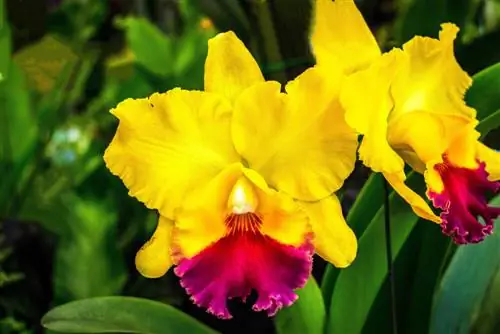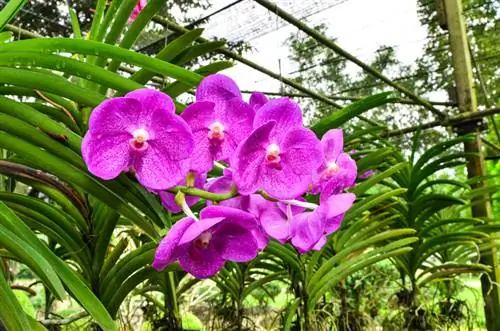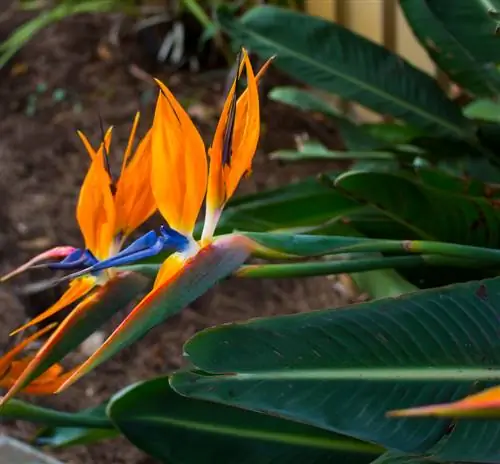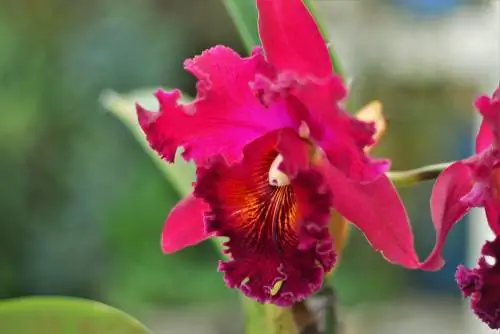- Author admin [email protected].
- Public 2023-12-16 16:46.
- Last modified 2025-01-23 11:21.
It is a must for orchid lovers: The Cattleya fascinates with its large, colored flowers in numerous different tones. However, the approximately 45 indoor species and their hybrids all require increased attention so that they fully develop their beauty and you can enjoy them for a long time.
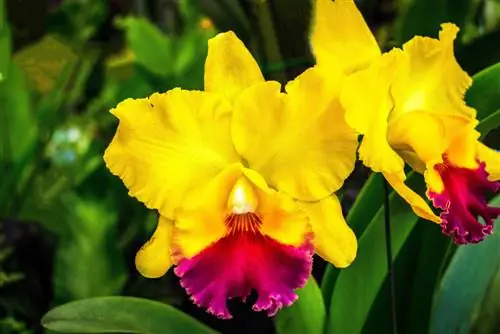
What are the care requirements for a Cattleya orchid?
The Cattleya orchid is an exotic houseplant prized for its large, colorful flowers in a variety of tones. It requires a bright location, high humidity, special orchid substrate and careful watering to thrive and bloom successfully.
Origin and distribution
The Cattleya orchids are native to the tropical rainforests of South America, where they grow either epiphytically (i.e. tree-dwelling) or lithophytically (i.e. on rocks). The genus was the first from the large family of exotic orchids (Orchidaceae) to reach Europe in the 19th century. They soon became very popular here, so much so that in aristocratic circles it was considered chic to wear a Cattleya flower in your buttonhole. The genus is named after William Cattley, an English orchid collector. In 1818 he was the first to successfully cultivate the beautiful exotic species in Europe.
Appearance and growth
The growth habit of Cattleya orchids is characteristic of many orchid species that occur in nature as epiphytes and therefore survive almost entirely without soil. The base forms a creeping rhizome, from which thickened shoots often arise during the growing season. This thickening, known in technical terms as a pseudobulb, serves as a reservoir for water and nutrients for the plant. Also typical of the genus is the sympodial growth habit, in which new shoots always arise at the base of the old, fully grown ones. On average, Cattleya orchids reach a height of around 25 centimeters.
leaves
The one or two fleshy, leathery leaves sit at the upper end of the thickened shoot axis, the pseudobulb. How many leaves there are on the Cattleya depends on the species. Botanists distinguish between single-leaf (unifoliate) and two-petal (bifoliate) Cattleya orchids. The leaves typically have a broad, elliptical to lanceolate shape.
Bloom and flowering time
The very large flowers of the Cattleya orchid usually appear in either spring or fall. They last for several weeks to months before they wither, but due to their size and therefore their weight, they have to be tied up. Otherwise the flower shoots could bend or even break off. While the large-flowered species usually produce no more than four flowers per stem, the small-flowered varieties and hybrids have up to 14 or, as with Cattleya guatemalense, even up to 20. However, Cattleya orchids are primarily through popular for their wide color spectrum, which ranges from red and pink to brown, yellow and orange to white in different tones. Many varieties are also multicolored or spotted. In addition, some variants delight with their intense, sweet-spicy scent, for example the popular Cattleya intermedia.
Toxicity
The Cattleya orchid is considered non-toxic, and there are no known indications of possible intolerances.
Which location is suitable?
The exotic Cattleya orchid is definitely not a houseplant for beginners. The sensitive flowers should be kept at a constant temperature of 20 °C and a high humidity of at least 50 percent, ideally 80 percent. With regard to light intensity, all Cattleya species require a very bright location, which can even be in full sun after a short acclimatization period. The flowers are particularly beautiful if the plant is allowed to stand in a south-facing window from September to May - only here does it get enough light in the dark season. If it is too dark for the Cattleya - which applies all year round - it only produces empty leaf sheaths, so that it no longer flowers.
Substrate
In nature, Cattleya orchids, as epiphytes, have little or no contact with soil. For this reason, commercially available, possibly pre-fertilized, potting soil is completely unsuitable for cultivating sensitive plants. Instead, the orchids feel most comfortable in coarse pine or pine bark, which you mix with a little sphagnum (if possible, only use the disinfected material from specialist retailers and not anything collected in the forest!), perlite and a few horn shavings / horn meal.
Alternatively, you can purchase special orchid substrate from a gardening store (€24.00 on Amazon), although some orchid retailers offer Cattleya soil specially mixed for the needs of Cattleya orchids.
Planting and repotting
Replant the Cattleya orchid in a larger pot about every two to three years, ideally using a special, transparent orchid pot. Although these are quite expensive with a purchase price of at least ten euros, they take the special needs of the epiphytes perfectly into account. They ensure that the long roots get enough light and air, can stretch out to the sides and at the same time make the development of waterlogging - the number 1 cause of death for orchids - impossible.
And this is how we plant:
- Take the Cattleya orchid out of the pot.
- If necessary, dip them in a water bath to make the roots easier to loosen.
- Disinfect sharp scissors or knife.
- Cut off old, rotten roots and old bulbs without roots and leaves.
- Remove old pieces of substrate.
- Fill some orchid substrate on the bottom of the pot.
- Place the orchid in the middle.
- Fill in the remaining substrate, filling the spaces between the roots.
- However, do not hurt any roots.
The cattleya then has to recover from this stress and may look a bit “offended” in the following two weeks. Leave them alone if possible and just spray them with a little water from time to time.
The ideal date for repotting depends on the flowering time of the plant: autumn-flowering cattleya receive fresh substrate and a new pot in spring, while spring-flowering plants receive fresh substrate and a new pot in autumn.
Cattleya watering
During their flowering period, Cattleya orchids require a lot of water and dry out quickly. Two waterings a week make sense at this point, but each time you should water so abundantly that the water flows out of the drainage holes in the bottom of the pot. Between each watering, the substrate should feel almost dry, but not dry out completely. Experienced orchid gardeners use the weighing method to determine the optimal watering time: The pot and plant are watered immediately after watering because that is when it is heaviest. After about three to four days, weigh again and the pot should then weigh significantly less. If this is not the case, there is no need to water yet. By the way, this also applies if the substrate already feels quite dry.
Outside the flowering period, however, the Cattleya requires much less water. Now it can survive for two to three weeks without any water. Some orchid owners don't water their Cattleya at all over the winter months.
Fertilize Cattleya properly
As epiphytes, Cattleya orchids are used to a nutrient-poor environment. Like all orchids, they react particularly sensitively to s alt. On the other hand, the formation of large flowers costs the plant a lot of energy, which has to be replenished through fertilization. If possible, use a liquid orchid fertilizer that is only half as strong as recommended by the manufacturer. Administer this every two weeks together with the irrigation water.
Cut Cattleya correctly
Apart from completely removing spent flower stems, pruning is not necessary for Cattleya orchids.
Propagate Cattleya
You can propagate large specimens of Cattleya orchids simply by dividing the rhizome. It is best to do this together with the plant, which is due to be repotted anyway. Using a sharp and disinfected knife or scissors, separate the rhizome into several sections, each of which should have at least three bulbs. Then plant the pieces separately in new pots.
Wintering
If the flowers of the cattleya orchid wilt, the leaves often begin to wilt as well. This is usually not a sign of an illness, but rather a completely normal process: In this way, the flower indicates that it is now entering the resting phase. This does not necessarily take place during the winter months, but rather depends on when the Cattleya is in bloom. Remove fallen and wilted leaves and flowers to prevent pathogens or pests from settling there. Also keep the plant cooler than usual at around 15 °C for a few weeks, water it less and stop fertilizing. As soon as the first new shoot appears, the Cattleya orchid ends its rest period all by itself. Now care for them again as usual.
Diseases and pests
Incorrect care and unsuitable location conditions make Cattleya orchids susceptible to various diseases or pest infestation. Beautiful houseplants often die because they are literally watered to death. Therefore, be careful not to water too much and not allow waterlogging to occur in the first place.
The so-called black rot, which primarily affects the young orchid shoots, is also problematic. Within a very short time these turn black and rot. You can sometimes save the plant by generously cutting away the diseased areas - deep into the he althy tissue - and dusting the cut areas with charcoal powder.
If the Cattleya is in an unfavorable location, uninvited pests such as thrips, spider mites (“red spiders”) or scale insects often appear.
Tip
Place the Cattleya outside in a bright, but not directly shady spot during the summer months.
Species and varieties
Cattleya orchids come in many shapes and colors, with various hybrids being sold in addition to the numerous species. We present some of the most beautiful varieties to you here:
- Cattleya labiata: intensely fragrant flower clusters in many colors, autumn blooming
- Cattleya bowringiana: purple to pink, shiny flowers, autumn blooming
- Cattleya cuttata: dark red spotted flowers, bloom between August and October
- Cattleya aurantiaca: orange flowers, spring blooming
- Cattleya 'Williette Wong': large, bright yellow flowers, hybrid
- Cattleya 'Floweringsize': very large flowers in various shades of blue, hybrid
- Cattleya 'Chia Lin': deep pink flowers with shaded lip, hybrid
- Cattleya 'Angel Kiss': bright orange flowers, hybrid

